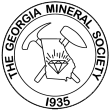Graves Mountain,
Lincolnton, GA

PHOSPHATE MINERALS AT GRAVES MOUNTAIN, GEORGIA
by Dr. Henry Barwood, GMS Member
Graves Mountain is a well known locality formerly mined for kyanite by Combustion Engineering. The mine was developed in a quartz-kyanite rock that is also rich in pyrite, pyrophyllite,rutile and lazulite. The area is probably best known for the world class rutile crystals found there, but is also noted for specimens of lazulite and pyrophyllite. Until recently little attention was paid to the secondary phosphates and phosphosulfates present in the kyanite-quartz-lazulite rock. To date the area has yielded: lazulite, woodhouseite, variscite, strengite, phosphosiderite, cacoxenite, crandallite along with accessory quartz, pyrite, pyrophylite, dickite, jarosite and sulfur crystals. Except for the lazulite, these are all micro crystals and are found in cavities that have distinct angular shapes, possibly reflecting where anhydrite was corroded and dissolved. Many of the species form pseudomorphs, notably crandallite, woodhouseite and phosphosiderite after lazulite and phosphosiderite after pyrite.
Phosphate Minerals:
lazulite:
Lazulite was one of the early minerals recognized at Graves Mountain and specimens were distributed worldwide over 100 years ago. Crystals to several inches are known, but the majority are under 2 cm. in size. Two distinct types of specimen material are known. There is a gray hard kyanite-quartzite that contains lazulite crystals, and there is a whitish friable kyanite-quartzite that appears more like a sandstone. The latter yields, by far, the best crystals, but is no longer exposed in the mine area. While weathering would be considered a prime candidate for the friable matrix of these lazulites, there is little evidence that they have been altered and it is likely that the quartzite was not cemented or had the cement removed by some other process. Friable material containing highly altered lazulites and heavily stained with iron oxides was recovered in 1969, lending further credence to a non-weathering origin. The hard gray lazulite rock is in demand for lapidary material and also contains the vuggy material that yields unusual micromounts.
variscite:
Variscite was not recognized as occurring at Graves Mountain until relatively recently. Prismatic green and colorless crystals to several millimeters occur in seams and vugs sporadically distributed in the kyanite-lazulite-quartzite unit. The colorless crystals are almost iron free. Early specimens of the green colored material were identified as wavellite, but no wavellite has been confirmed from Graves Mountain. Rarely variscite is found as prisms on large quartz crystals in the quartz veins cutting the lazulite unit. Variscite is also a component, along with woodhouseite and crandallite of the white altered portions of lazulite crystals.
woodhouseite:
Woodhouseite crystals were identified by XRD in 1991 and have since been recognized as a widespread component of the kyanite-lazulite-quartzite. The crystals are up to several millimeters in size and usually light tan in color. The woodhouseite is often an inclusion in variscite crystals, forms alteration zones in lazulite and also alters to chalky masses of crandallite.
strengite:
Strengite was only recently collected as rather large pink prismatic crystals lining a vein in a very weathered kyanite-lazulite-quartzite boulder on the dump of the East pit. The crystals have not yet been analyzed, but the distinctive sword shape and pink color suggests that they are strengite.
phosphosiderite:
In 1969, on the last organized field trip into the active mine, the author located a zone of granular, weathered, iron stained kyanite-lazulite-quartzite that contained corroded lazulite crystals and casts after lazulite. Most of the corroded lazulite had been converted to brilliant sulfur-yellow jarosite and transparent, light pink crystals of phosphosiderite. Despite numerous requests to collect more, the material was all run through the plant and only the sparse samples collected in 1969 were preserved.
cacoxenite:
Weathered kyanite-lazulite-quartzite on the dumps of the East pit has yielded a few small cavities with tiny “puff-balls” of yellow cacoxenite fibers.
crandallite:
Crandallite forms much of the white, chalky alteration product of the lazulite crystals. Some anhydrite (?) casts in the lazulite zone contained botryoidal crusts of crandallite and a few specimens exhibited tiny scalenohedral crystals coating the surfaces.
Accessory Minerals:
quartz:
Tiny clear quartz crystals typically line the casts found in the lazulite zone. The most interesting specimens are overgrowths on grains of blue quartz in the original quartzite that give the crystals a distinct translucent blue color. Inclusions of rutile and pyrite are common.
kyanite:
Rare transparent blue crystals of kyanite are sometimes found in the casts, but most of the kyanite is altered to pyrophyllite and dickite.
pyrite:
In places, excellent cubes and cubo-octahedrons of pyrite are found perched on the quartz and kyanite. Most of the pyrite is massive and contained in the quartzite groundmass and not in the cavities.
rutile:
Tiny black to deep red blebs of rutile are found in the cavities, but are very seldom found as good crystals. While the larger rutiles are superb, good micromounts of rutile are rare at Grave Mountain.
pyrophyllite:
Clear greenish prisms of pyrophyllite are common in the casts, but the pyrophyllite is extremely brittle and usually bridges any open cavities. Rare intact crystals are among the finest micros of pyrophyllite known.
dickite:
Much of the interior of the casts is coated with a colorless micaceous material that proved to be dickite when analyzed. Some of the crystals form distinct pseudohexagonal platelets and are exceptional, if small, crystals of a true “clay” mineral.
jarosite:
Crystals of jarosite ranging from sulfur yellow to deep brown are not uncommon in weathered portions of the lazulite zone. Yellow and pink pseudomorphs of jarosite and phosphosiderite after lazulite have been found and yellow pseudomorphs after pyrite crystals are not uncommon.
sulfur:
Tiny transparent yellow crystals of sulfur are found in pyrite rich samples in the lazulite zone. They are hard to observe because of their size and transparency, but have been confirmed by X-ray analysis (and the fact they melt and evaporate in an electron beam!)

Let's Dig!
Copyright © Georgia Mineral Society, Inc.
